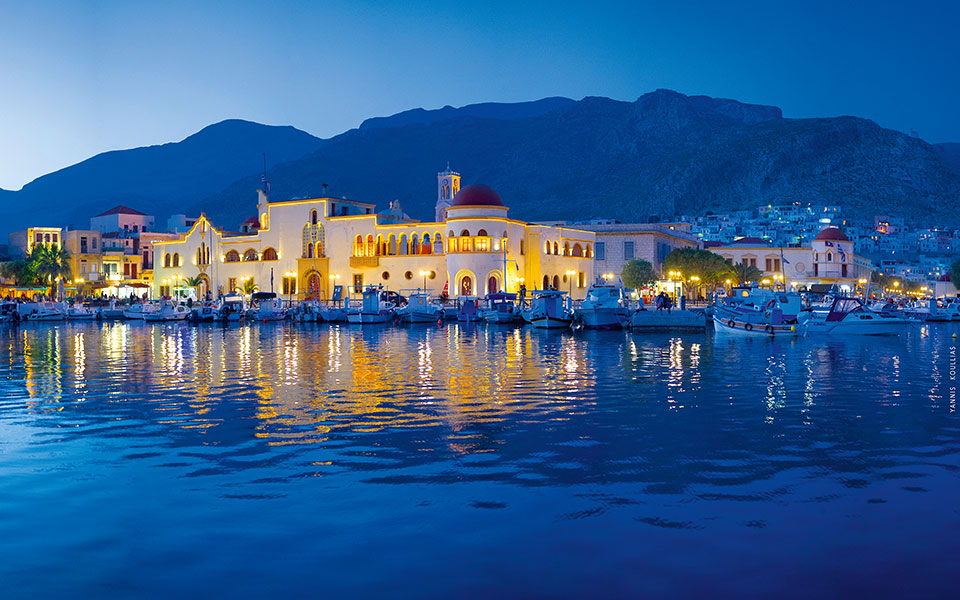EXPLORE
THE PORT AND CAPITAL: Pothia is a colorful and lively place, full of ouzeries (restaurants serving ouzo and small mezes) and cafés, with boats lining the waterfront. It is graced by simple island homes and two-story neoclassical buildings from the prosperous 19th and early 20th centuries, when captains and merchants accumulated wealth on long voyages and sent money back home. Take a walk on the beachfront and through the most beautiful neighborhood, Patithries. Stop for a look at the 1930s Town Hall (once the headquarters of the Italian occupation) and the Cathedral of the Transfiguration of Jesus Christ (1861), with its marble iconostasis by the great Tinos sculptor Yannoulis Chalepas (1851-1938) and icons by great local artists.
DIVE INTO HISTORY: You can learn about the history of sponge diving in Kalymnos at the small Naval Museum (Tel. (+30) 6978.280.313, by appointment) and at the Traditional Kalymnian House (Tel. (+30) 22430.516.35, open daily 08:30-15:00 & 17:00-20:00), where Faneromeni Skylla-Halkidou, the daughter of a sponge diver, shares moving stories about the dangerous profession from the perspective of the women who stayed behind and fretted over the lives of the divers.
Info
- Area: 110 sq. km.
- Population: 16,180 (2011 census)
- Distance: 183 (sea miles from Piraeus)
- Highest Peak: 760m (Profitis Ilias)
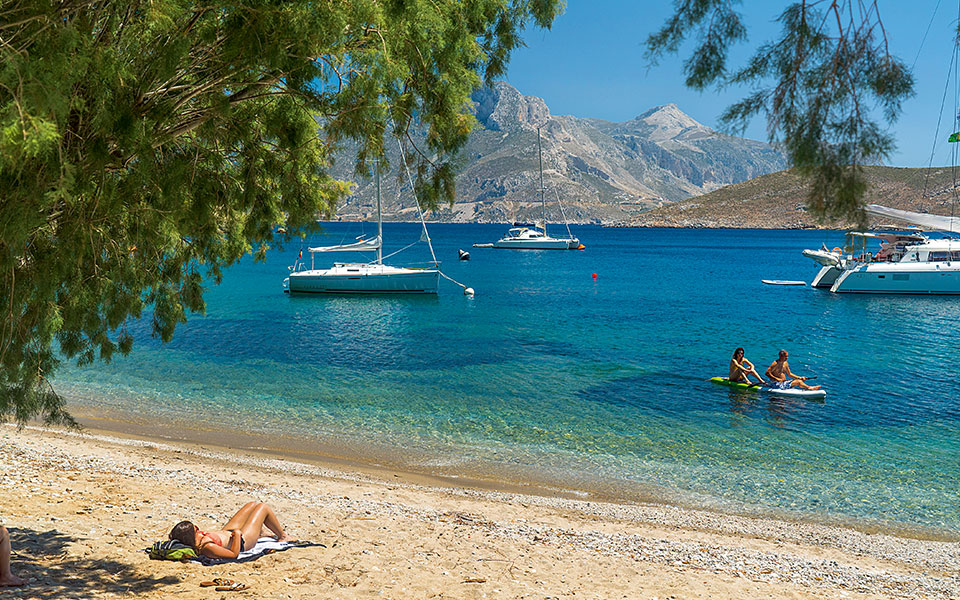
© Perikles Merakos
THE CASTLES: A good time to walk through the whitewashed alleys of Hora (also called Horio), the old capital of the island – basically a continuation of Pothia – is in the soft afternoon light. Visit the remains of the small Chrysocheria Castle, with its beautiful view of Pothia, before climbing up to the old neighborhoods to the north and finding the stone-paved path to the Castle of Hora. Built by the Order of the Knights of Saint John at the end of the 15th century atop earlier stone fortifications, the castle overlooked Pothia and the sea from a strategic position. Wander carefully among the ruined houses and admire the strong castle walls, some restored buildings, the chapels and the coats of arms of the knights.
TAKE A PEEK: Make a stop on the road that leads from Hora to Panormos to see an interesting little archaeological site that includes the remains of the 5th-c. Church of Christ of Jerusalem as well as mosaics, fragments from the ancient city and from the temples of Delian Apollo and Asclepios, as well as the newer chapel of Ipakois. Unfortunately, you’ll have to peer at it all through the fence, as the area is not open to visitors.
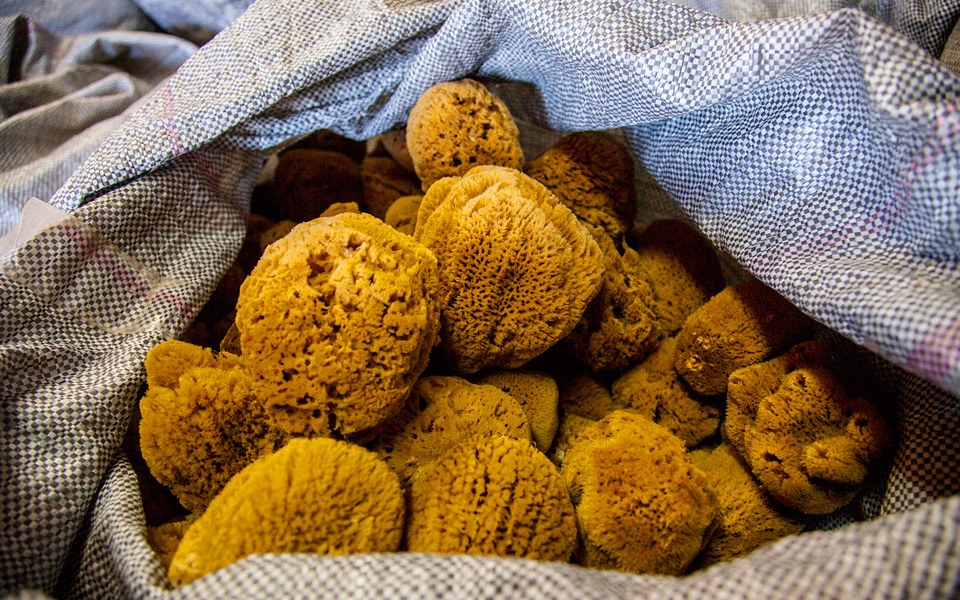
© Olga Charami
FOCUS: SFOUGARADES, THE SPONGE DIVERS OF KALYMNOS
Sponge diving, one of the most dangerous professions in the world, has defined Kalymnos in every possible way, bringing the island both great wealth and great pain. Hundreds of caïques would leave after Easter for the North African coast, coming back in October. The women would see their men off wearing white headscarves, which they would swap for black ones during their absence. The bells of twenty parishes would ring in unison for every returning caïque that flew its standards high, while for those that flew them half-mast, a collective mournful toll would begin, since that meant that some of the crew had been lost.
Until the development of the standard diving dress in 1870, sponge divers would free-dive as far down as 70m. The suit helped prolong their stay on the sea bed, but it also meant they had to decompress after diving. Such safety measures meant little to these men; their bonuses and their own sense of pride would cause them to disregard precautions in place to protect them. This is, in a way, how the bends “epidemic” came about. In the first 30 years of the standard diving dress, Kalymnos lost 800 divers; 200 more were paralyzed. Today, there are about 80 active sponge divers left; with the present dearth of sponges, they collect mostly seashells.
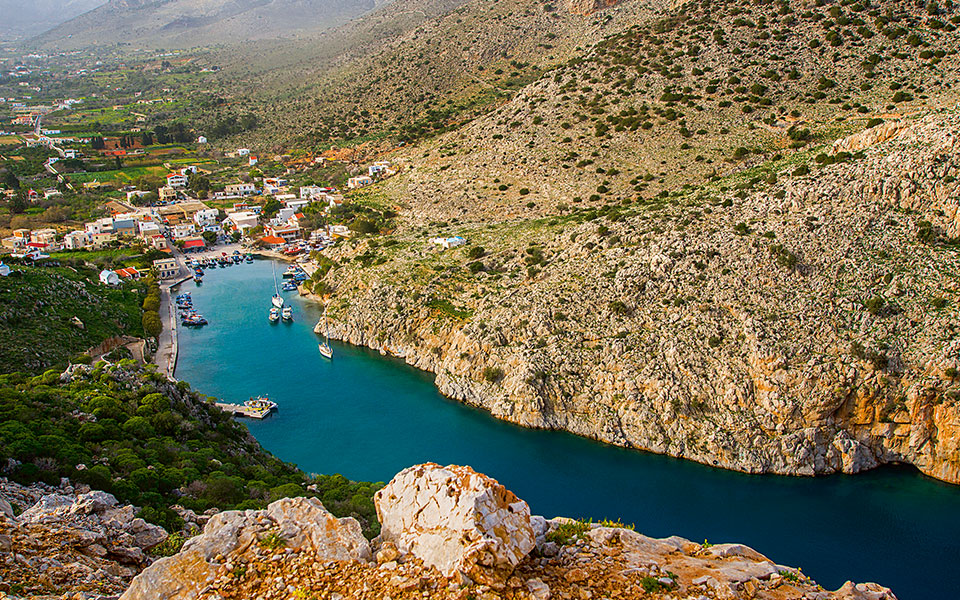
© Clairy Moustafellou
EXPERIENCE
THE DAILY CATCH: Kalymnos prides itself for having one of the largest coastal fishing fleets in the Mediterranean, with 600-700 fishing boats and 1,000 professional fishermen. Meet them at the fishermen’s wharf in Pothia, as they bait fishing lines and beat octopuses against the rocks to tenderize them. The Social Cooperative Enterprise “Kalymnos Seafood” sells exquisite delicacies made by local women, including swordfish, octopus ink paste, and white tuna smoked with thyme, savory and oregano.
CAN’T LEAVE WITHOUT THEM: Shop for sponges in Pothia’s workshops or just learn about the complicated processing methods used to produce the commercial product. Papachatzis, Makryllos and Haramis are willing to explain everything to you.

© Nicolas Smalios
GO ROCK CLIMBING: Kalymnos is one of the best rock climbing destinations in the world, with more than 3,800 climbing routes and dozens of schools. Interesting areas to visit are Masouri and Armeos, in the west, where huge boulders rise sharply above the sea and the surrounding settlements. A useful read is the guidebook written by our insider, Aris Theodoropoulos, a pioneer of climbing on the island (climbkalymnos.com). Even if you don’t make the climb, this is a place where you can find some of the most popular beaches (Kantouni, Platys Gialos, Linaria and Masouri) and take in a magnificent spectacle, as the sun goes down over neighboring Telendos, vanishing behind the impressive pointy silhouette of the island.
EVERYBODY’S DIVING: The first word that springs to mind when someone says “Kalymnos” is diving, thanks to its long sponge diving tradition. Home to the first-ever state-owned school for professional divers, the island is exempt from the diving restrictions that exist nearly everywhere else in Greece and is ideal for underwater explorations. Marine life is abundant and there are underwater caves, chasms and shipwrecks to explore. Kalymnos Diving Club (Tel. (+30) 6974.646.413).
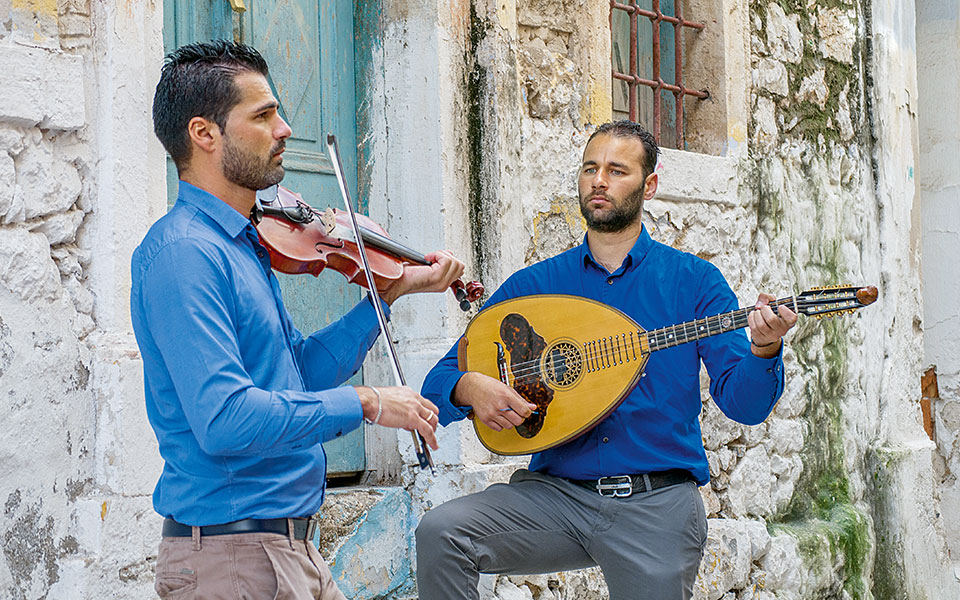
© Clairy Moustafellou
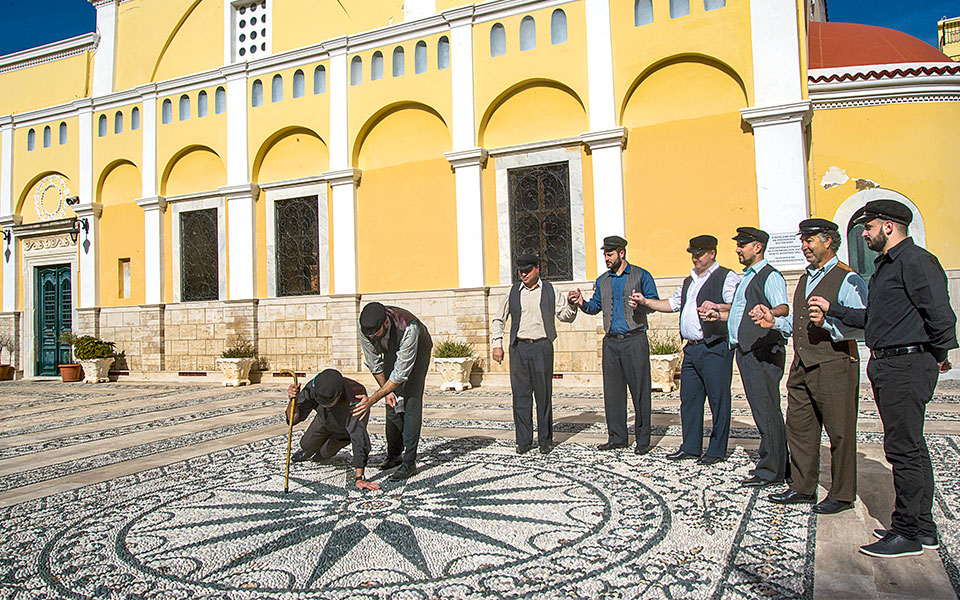
© Clairy Moustafellou
A REWARDING ROUTE: A right turn after the village of Skalia, in the west part of the island, will bring you to a winding eastbound road that overlooks the climbing fields. Once you reach the east coast, the landscape changes. From here, you can see the impressive barren slopes that smell of thyme and oregano; across the water, your view includes the neighboring islands of Leros and Lipsi, the Imia islets and the Turkish coast. (Along the way, there’s a downhill path that leads to the remote sandy beach of Sykati – a 30-minute walk – with emerald-green waters).
At the end of the road, you’ll find yourself on Palionissos Beach, one of Kalymnos’ most beautiful locations. The pebbled beach, with its shady tamrisk trees, faces an idyllic closed bay. It’s a perfect place to lie down and listen to the cicadas. Don’t be surprised if a seagull approaches you looking for a treat. If you get hungry yourself, Makarouna Taverna is famous for its slow-baked goat.
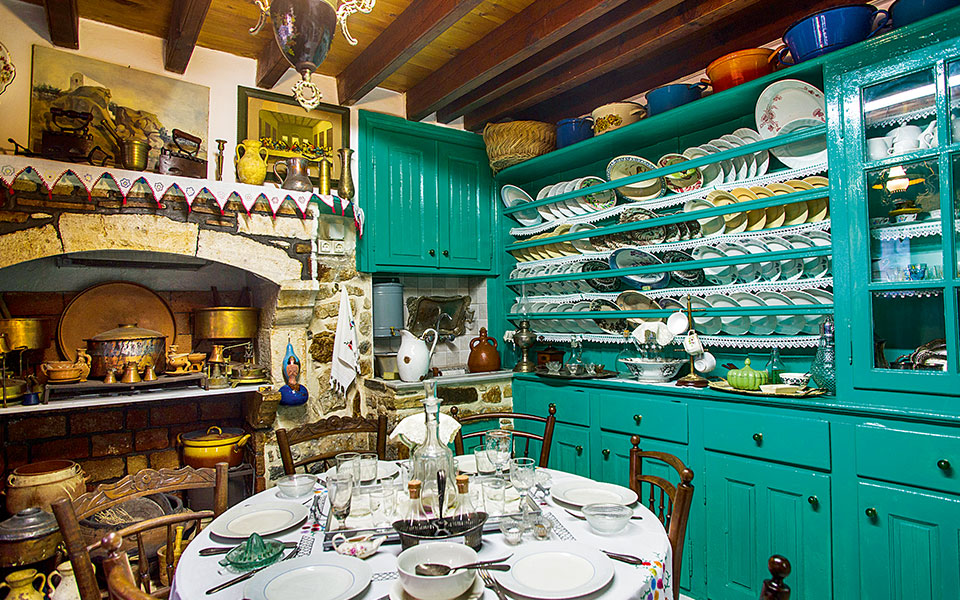
© Clairy Moustafellou
THE FJORD: Vathy is a large valley (full of citrus trees) that terminates in an impressive “fjord” at Rina Harbor. Walk along the waterfront, dive off the piers or the famous big boulder of Rina, or slip into one of the Byzantine churches here. The most beautiful of them all is the 6th-c., three-aisled Taxiarchis, built among the ruins of ancient fortifications. If you rent a kayak and paddle through the fjord, you can make your way to nearby Daskalio Cave and check out its stalactites (Kalymnos Kayak Center, Tel (+30) 22430.311.32).
GO HIKING: Kalymnos offers great walking routes, too. One of the most beautiful paths, in the eastern part of the island, will lead you to the Panaghia Kyra Psili Monastery, built in part within a cave. The steep uphill hike lasts about 30 minutes. It’s not known when the monastery was built, but it is beloved by the locals and the celebration of the Dormition of the Virgin Mary on August 15 is spectacular. Another nice route, in the west, runs parallel to the sea and leads from Kantouni Beach to the Chapel of Aghios Fotis (approximately 45 minutes).
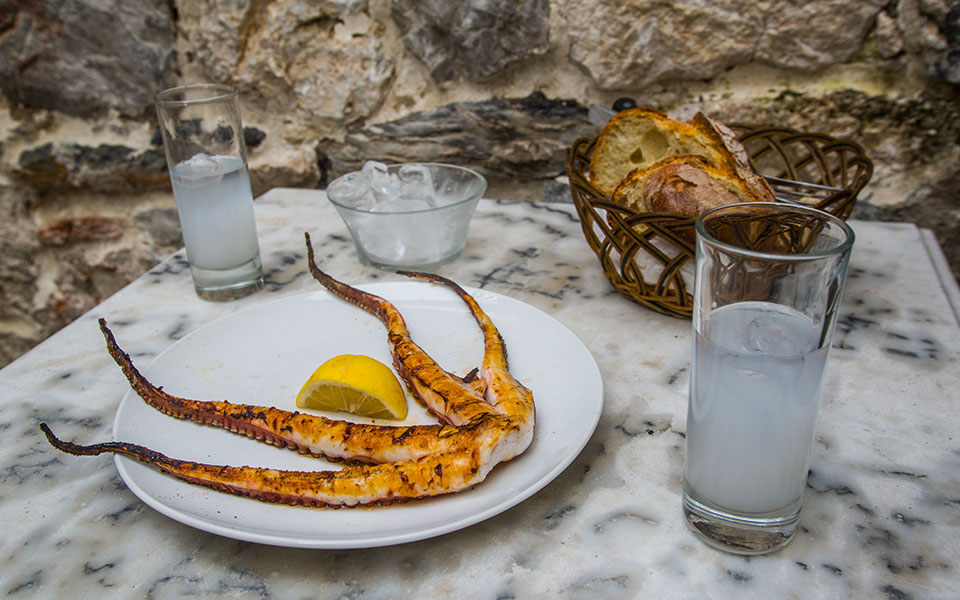
© Clairy Moustafellou
TASTE
LOCAL SPECIALTIES: The two must-try dishes of Kalymnos are the fylla (vine leaves stuffed with minced meat and rice) and the mououri (goat stuffed with rice and giblets, slow-baked in a sealed clay pot). You should also stick a fork into the mermizeli salad.
CITRUS KINGDOM: The Valley of Vathy is full of citrus orchards hidden behind tall walls. You can purchase citrus products, including marmalades, liqueurs and sweets from the Amfipetran Youth Club (Tel. (+30) 694.160.5006). The Perivoli Café, located amid the orchards, has the feel of a Mexican hacienda and features live music nights.
WHERE TO EAT: Kalymnians often dip grilled octopus into a glass of ouzo; supposedly both become tastier this way. Do it yourself at Sfougaras in Pothia, where you can also taste octopus fritters, spinialo (shellfish preserved in sea water) and lobster tails.
After a day at Panormos Beach, go to Mamouzelos Taverna for fresh fish and shellfish, pasta with lobster and other seafood specialties.
Another place with great seafood cooked in inspiring ways is the Aegean Tavern (aka Aegeopelagitiko) in Masouri. Go before dark to enjoy a view of Telendos from its lovely terrace and try the roasted octopus, lobster spaghetti and steamed mussels.
Authentic local dishes are also served at Tsopanakos in Masouri – the owner is a farmer who serves his own meats and cheeses, as well as fylla, mououri goat and homemade bread.

© Olga Charami
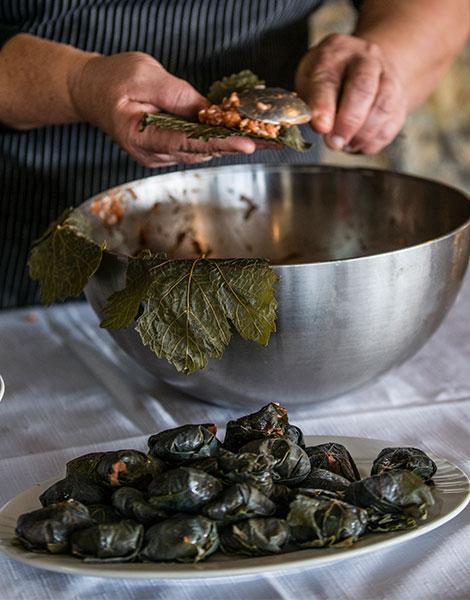
© Clairy Moustafellou
SUGAR CRAVINGS: Michalaras café-pâtisserie in Pothia is famous for its desserts, particularly its galaktoboureko (custard pie with syrup) made with fresh milk. For a sweet souvenir from Kalymnos, call the Kopanezos family: they keep their beehives on remote rocks and let the bees do their magic undisturbed, producing an exquisite thyme honey which you can purchase at their outlet in Vathy (Tel. (+30) 22430.294.46).
HAPPY HOUR: The most popular bars on Kalymnos are on Linaria Beach: the famous Domus, Albus and Rock & Blues. For nice cocktails in a different setting (in an amazing courtyard with lemon trees) head to Monopoly in Pothia.

